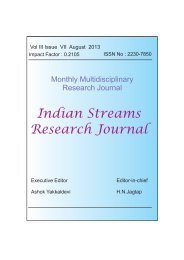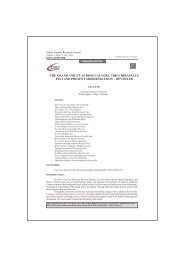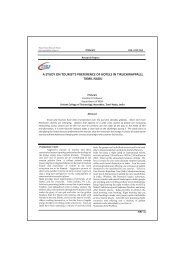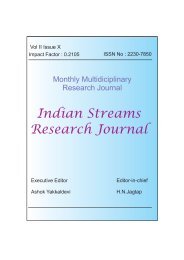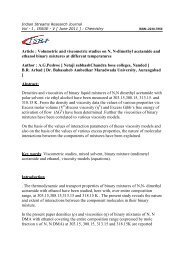Article : Mobilization of Funds by District Central Co-operative Banks ...
Article : Mobilization of Funds by District Central Co-operative Banks ...
Article : Mobilization of Funds by District Central Co-operative Banks ...
You also want an ePaper? Increase the reach of your titles
YUMPU automatically turns print PDFs into web optimized ePapers that Google loves.
Indian Streams Research JournalVol - I , ISSUE - V [ June 2011 ] : <strong>Co</strong>mmerceISSN:-2230-7850<strong>Article</strong> : <strong>Mobilization</strong> <strong>of</strong> <strong>Funds</strong> <strong>by</strong> <strong>District</strong> <strong>Central</strong> <strong>Co</strong>-<strong>operative</strong> <strong>Banks</strong> inMaharashtraAuthor : Mr. M. J. Mane [ P. V. P. Mahavidyalaya, Kavathe Mahankal. Dist-Sangli ]Dr. V. B. Kodag [ G. A. <strong>Co</strong>llege <strong>of</strong> <strong>Co</strong>mmerce, Sangli ]1.1 Introduction:-The co-<strong>operative</strong> credit societies and DCC <strong>Banks</strong> in Maharashtra are playing keyrole in the growth <strong>of</strong> agriculture expansion <strong>of</strong> rural development and social andcultural activities. Maharashtra State is the pioneer and rank first in the growth <strong>of</strong>co-<strong>operative</strong> movement in India. The Maharashtra co-<strong>operative</strong> societies Act waspassed in 1960. In co-<strong>operative</strong> sector in Maharashtra there is primary agriculturalcredit co-<strong>operative</strong>s, non-agricultural credit co-<strong>operative</strong>s, marketing co<strong>operative</strong>s,productive co-<strong>operative</strong>s, sugar co-<strong>operative</strong>s, land development bank,state co-<strong>operative</strong> bank and DCC <strong>Banks</strong> are leading more. The various federal co<strong>operative</strong>sat the state level are famous and at the national level also. It has beendeveloped quantitatively and qualitatively more, comparatively with the otherstate. Maharashtra is leading in all the states in various co-<strong>operative</strong> sectors likeproductive, process, marketing, banking and housing co-<strong>operative</strong>s also. The co<strong>operative</strong>credit movement in Maharashtra (old) Bombay presidency made a slowas compared to the spectacular growth in other part <strong>of</strong> country. The first ruralcredit society in Bombay presidency, the “Kanginhal Rural <strong>Co</strong>-<strong>operative</strong> CreditSociety” was registered on 8 th May, 1905 in Dharawar district. Headed <strong>by</strong> thevillage Patil known for his organizational capacity, it created a deep impression inevery first year <strong>by</strong> recovering its dues fully, even though its area <strong>of</strong> operationsuffered from severe society. A land mark in the early history was the registrationon 23 rd January, 1906 <strong>of</strong> the Bombay Urban Credit <strong>Co</strong>-<strong>operative</strong> Society sponsored<strong>by</strong> Vitthaldas Thakersey Lallubhai Samaldas. It was registered as primary urbancredit society but was meant to function as central society, with the sole subject <strong>of</strong>financing rural societies.The first phase <strong>of</strong> the co-<strong>operative</strong> movement in Bombay presidency was over on31 st March, 1911. It was observed from the growth <strong>of</strong> the co-<strong>operative</strong> societies inBombay presidency that, no DCC Bank was established up to 31 st March, 1911. Asin the absence <strong>of</strong> financing agencies, an urban credit society was allowed to lend
Indian Streams Research JournalVol - I , ISSUE - V [ June 2011 ] : <strong>Co</strong>mmerceISSN:-2230-7850surplus funds to rural primary societies. This facility helped the society to crossregional and language barriers and bring co-<strong>operative</strong> workers in the presidencycloser. In spite <strong>of</strong> the erratic fluctuations in the economic trends, the co-<strong>operative</strong>movement in the presidency received tremendous boost during 1911-1924, onaccount <strong>of</strong> the establishment <strong>of</strong> central co-<strong>operative</strong> banks. The Bombay <strong>Central</strong><strong>Co</strong>-<strong>operative</strong> Bank was also registered on 11 th October, 1911. The DCC Bank arealso plays prominent role in the development <strong>of</strong> rural and drought areas in the state<strong>of</strong> Maharashtra. According to 2007-08, there nearly about 31 DCC <strong>Banks</strong> and its3683 branches with the head-<strong>of</strong>fice were working in the state <strong>of</strong> Maharashtra. Thechief object <strong>of</strong> DCC <strong>Banks</strong> is to meet the credit requirements <strong>of</strong> member societiesand other co-<strong>operative</strong> societies in its area <strong>of</strong> operation. The efficiency in theperformance <strong>of</strong> DCC <strong>Banks</strong> always depends on the mobilization <strong>of</strong> the requiredamount <strong>of</strong> funds. The researcher is interested in knowing the efficiency with whichdifferent sources were used <strong>by</strong> the DCC <strong>Banks</strong> for mobilizing the required funds.Therefore, the present study is entitled as, “<strong>Mobilization</strong> <strong>of</strong> <strong>Funds</strong> <strong>by</strong> DCC <strong>Banks</strong>in Maharashtra.1.2 Objectives <strong>of</strong> the Study:The present study has been under taken with the following objectives:-• To study the different sources used <strong>by</strong> the <strong>District</strong> <strong>Central</strong> <strong>Co</strong>-<strong>operative</strong> <strong>Banks</strong>in Maharashtra for mobilizing the required funds.• To study the trends <strong>of</strong> different sources <strong>of</strong> DCC <strong>Banks</strong> in Maharashtra.• To study whether the growth in deposits accompanied <strong>by</strong> similar growth in theowned funds and total assets <strong>of</strong> the DCC Bank.1.3 Methodology:The present study is totally based on the secondary data and literature. Theinformation relative to the deposits, share capital, reserves and total assets <strong>of</strong> theDCC <strong>Banks</strong> in Maharashtra is secondary in nature and this data which has beencollected from Issues <strong>of</strong> <strong>Co</strong>-<strong>operative</strong> Movement at Glance in Maharashtra for2007, 2008 and report <strong>of</strong> National Federation Of State <strong>Co</strong>-Operative <strong>Banks</strong> Ltd.,performance <strong>of</strong> DCC <strong>Banks</strong> in India for 2008-09.For the interpretation and analyzing the collected secondary data, simplestatistical techniques are used in this present study like annual growth rate (AGR),
Indian Streams Research JournalVol - I , ISSUE - V [ June 2011 ] : <strong>Co</strong>mmerceISSN:-2230-7850mean, co-efficient <strong>of</strong> variation, percentage etc. The scope <strong>of</strong> the study is alsolimited to a DCC <strong>Banks</strong> in Maharashtra. The present research work covers a period<strong>of</strong> 7 years only from 2001-02 to 2008-09.1.4 Analysis <strong>of</strong> Data:A share capital, reserve funds and other reserves created <strong>by</strong> the DCC <strong>Banks</strong>out <strong>of</strong> its pr<strong>of</strong>its constitutes the internal source <strong>of</strong> the bank. But for effective andefficient working every DCC Bank has depend upon the external source likedeposits from public, member societies and individuals and borrowing from State<strong>Co</strong>-<strong>operative</strong> Bank and State Government. The share capital, reserves, deposits andborrowings <strong>of</strong> DCC <strong>Banks</strong> in Maharashtra during the period 2001-02 to 2008-09which is shown in the table- 1.1 is as follows:----- Table- 1.1Sources <strong>of</strong> <strong>Funds</strong> <strong>of</strong> DCC <strong>Banks</strong> in Maharashtra (Rs. In Crores)Sr. Year Owned <strong>Funds</strong> Borrowed <strong>Funds</strong> TotalNo.Share Reserves Deposits LoansCapital1 2001-02 903.30 4132.01 18620.92 2237.48 25893.712 2003-04 939.92 4715.25 23887.31 2361.67 31904.153 2004-05 1001.53 5082.77 24822.54 2266.89 33173.734 2005-06 1081.81 5809.70 26402.30 2575.66 35869.475 2006-07 1184.41 6322.21 27657.25 4514.03 39677.906 2007-08 1292.72 6966.00 31949.16 4249.06 44456.947 2008-09 1360.30 5667.08 37225.17 2941.08 47193.6311 Mean (x) 1109.14 5527.86 27223.52 3020.84 36881.3612 Percentage 03.01 14.99 73.81 8.19 100.0013 A.G.R. 7.08 6.09 12.56 8.96 11.69Source:- Issues <strong>of</strong> <strong>Co</strong>-<strong>operative</strong> Movement at a Glance in Maharashtra for 2007,2008.Report <strong>of</strong> NAFSCB on performance evaluation <strong>of</strong> DCC Bank in India for2008-09.The above table 1.1 shows that there is a increasing trend in share capital,reserves, deposits as well as in borrowings <strong>of</strong> <strong>District</strong> <strong>Central</strong> <strong>Co</strong>-<strong>operative</strong> <strong>Banks</strong>in Maharashtra during the study period i.e. 2001-02 to 2008-09. The share capital
Indian Streams Research JournalVol - I , ISSUE - V [ June 2011 ] : <strong>Co</strong>mmerceISSN:-2230-7850<strong>of</strong> DCC <strong>Banks</strong> was moved from Rs. 903.30 crores in 2001-02 to Rs. 1360.30crores in 2008-09 which has increased <strong>by</strong> Rs. 457 crores during the same period.The reserves <strong>of</strong> DCC <strong>Banks</strong> was moved from Rs. 4132.01 crores in 2001-02 to Rs.5667.08 crores in 2008-09, it is also increased <strong>by</strong> Rs. 1535.07 crores during thestudy period. The deposits collected <strong>by</strong> DCC <strong>Banks</strong> in Maharashtra also turnedfrom Rs. 18620.92 crores in 2001-02 to Rs. 37225.17 crores in 2008-09, which israised <strong>by</strong> Rs. 18604.25 crores. The borrowings <strong>of</strong> DCC <strong>Banks</strong> in Maharahstraduring the above period are increasing trends. It was moved from Rs. 2237.48crores in 2001-02 to Rs. 2941.08 crores in 2008-09, it is also increased <strong>by</strong> Rs.70.36 crores during the same period. Thus the average percentage <strong>of</strong> share capital,reserves, deposits and loans to the total sources <strong>of</strong> funds are 3.01%, 14.99%,73.81% and 8.19% respectively. The share capital as well as reserves registered agrowth <strong>of</strong> 50.59% and 37.15% respectively, while the growth in deposits it was99.91%. The positive average growth rate for share capital (7.08%) for reserves(6.09%) and for deposits 12.56% indicates that, management had attempted morefor strengthening the ‘Deposit Base’ <strong>of</strong> the DCC <strong>Banks</strong>. The co-efficient <strong>of</strong>variation (C. V.) values indicates more variations in the reserves as well as deposits<strong>of</strong> the DCC <strong>Banks</strong> in Maharashtra.The source <strong>of</strong> borrowed funds used <strong>by</strong> the DCC <strong>Banks</strong> management as shortterm,medium-term and long-term loans. The board <strong>of</strong> directors used these sourcesfor mobilizing funds during the study period. It shows that the board <strong>of</strong> directorswas not succeeded in mobilizing the required funds without borrowed loans duringthe study period. This was not prudent policies <strong>of</strong> DCC <strong>Banks</strong> in Maharashtrawhich resulted in increasing the cost and for the decreasing the pr<strong>of</strong>itability <strong>of</strong> thebank.The following table shows the trend <strong>of</strong> owned funds, deposits and total assets<strong>of</strong> the DCC <strong>Banks</strong> in Maharashtra during the period 2001-02 to 2008-09Table- 1.2Trends <strong>of</strong> Deposits, Owned <strong>Funds</strong> and Total Assets <strong>of</strong> DCC <strong>Banks</strong> inMaharashtra (Rs. In Crores)
Indian Streams Research JournalVol - I , ISSUE - V [ June 2011 ] : <strong>Co</strong>mmerceISSN:-2230-7850YearTotalDepositsOwned<strong>Funds</strong>TotalAssetsDeposittoOwnedFundRatioDepositto TotalAssetsRatio2001-02 18620.92 5035.31 31891.32 369.81 58.382003-04 23887.31 5655.17 32902.58 422.40 72.602004-05 24822.54 6084.30 34720.02 407.98 71.492005-06 26402.30 6891.51 36863.87 383.11 71.622006-07 27657.25 7506.62 40701.77 368.44 67.952007-08 31949.16 8258.72 45629.38 386.85 70.022008-09 37225.17 7027.38 50066.29 529.72 74.35Mean (x) 27223.52 6637.00 38967.89 409.76 69.49A.G.R. 12.56 06.30 07.85 06.12 04.52Source:- Issues <strong>of</strong> <strong>Co</strong>-<strong>operative</strong> Movement at a Glance in Maharashtra for 2007,2008.Report <strong>of</strong> NAFSCB on performance evaluation <strong>of</strong> DCC Bank in India for2008-09.Year Indices Base Year 2001-02Deposits Owned<strong>Funds</strong>TotalAssets2001-02 100.00 100.00 100.002003-04 128.28 112.31 103.172004-05 133.30 120.83 108.872005-06 141.78 136.86 115.592006-07 148.53 149.08 127.632007-08 171.58 164.02 143.082008-09 199.91 139.56 156.99Source:-<strong>Co</strong>mputed from Issues <strong>of</strong> <strong>Co</strong>-<strong>operative</strong> Movement at a Glance inMaharashtra for 2007, 2008.The above table- 1.2 indicates the position <strong>of</strong> deposits, owned funds as well as totalassets <strong>of</strong> the DCC <strong>Banks</strong> in Maharashtra which are in increasing trends during the
Indian Streams Research JournalVol - I , ISSUE - V [ June 2011 ] : <strong>Co</strong>mmerceISSN:-2230-7850study period. In order to know the trend <strong>of</strong> deposits, owned funds and total assets<strong>of</strong> DCC <strong>Banks</strong>, the indices values are calculated <strong>by</strong> taking <strong>by</strong> taking the figures <strong>of</strong>2001-02 as a 100. The indices <strong>of</strong> deposits, owned funds and total assets increasedcontinuously and reached 199.91, 139.56 and 156.99 respectively from 100 duringthe base 2001-02. The growth rate in the deposits, owned funds and total assets <strong>of</strong>the DCC <strong>Banks</strong> in Maharashtra during the period come to 99.91%, 39.56% and56.99% respectively.The paid up capital and various reserves created <strong>by</strong> the DCC <strong>Banks</strong> in Maharashtraout <strong>of</strong> pr<strong>of</strong>its constitutes. The ratio <strong>of</strong> deposits to owned funds has been calculated<strong>by</strong> dividing owned funds to total deposits and multiplies <strong>by</strong> 100. During the period2001-02, the deposits to owned fund ratio was 369.81%, whereas in the year 2008-09 it was 529.72% which is increased <strong>by</strong> 159.91% during the same period. Theratio witnessed proportionately more growth in the amount <strong>of</strong> deposits than thegrowth in the owned funds <strong>of</strong> the DCC <strong>Banks</strong> in Maharashtra. It indicates hugeinterest and confidence <strong>of</strong> depositors on the DCC <strong>Banks</strong> in state <strong>of</strong> Maharashtra.The source <strong>of</strong> total assets or the working capital <strong>of</strong> the DCC <strong>Banks</strong> are includes,paid-up share capital, reserve and surplus, deposits from PACCs, individuals andothers. The ratio <strong>of</strong> total deposits to total assets is ascertained <strong>by</strong> dividing the totalfigures <strong>of</strong> total assets to the figures <strong>of</strong> total deposits and multiplies <strong>by</strong> 100. Theratio <strong>of</strong> deposits to total assets <strong>of</strong> the DCC <strong>Banks</strong> in Maharashtra ranged between58.38% as minimum in 2001-02 to 74.35% as maximum in 2008-09; all an averagedeposits constitute 69.49% <strong>of</strong> the total assets during the study period.1.5 <strong>Co</strong>nclusion:It is found that from the above figures and analysis, the management <strong>of</strong>district central co-<strong>operative</strong> banks in Maharashtra has succeeded in mobilizing thetotal deposits collected <strong>by</strong> them from member societies, individuals and other co<strong>operative</strong>societies during the study period i.e. 2001-02 to 2008-09 due to thegrowth in owned funds as well as growth in total assets <strong>of</strong> the DCC <strong>Banks</strong>.REFERENCES• Abdul Kuddus K. A. and Zakir Hussian A. K., “<strong>Co</strong>-<strong>operative</strong> Credit andBanking”, Limra Publications, Chennai, 2007, P. 41-42.
Indian Streams Research JournalVol - I , ISSUE - V [ June 2011 ] : <strong>Co</strong>mmerceISSN:-2230-7850• Deshmukh P. G., “Working <strong>of</strong> <strong>Co</strong>-<strong>operative</strong> <strong>Banks</strong> in India”, Edi. 2002,Kanishka Publishers, New Delhi.• M. Shrinivas, “Organization and Management <strong>of</strong> <strong>Co</strong>-<strong>operative</strong> <strong>Banks</strong> inIndia”, Edi. 1990, Printwell Publisher, Jaipur, P-49.• Walkini W. P., “<strong>Co</strong>-<strong>operative</strong> Principles, Today and Tomorrow”, Edi. 2000,Published <strong>by</strong> Holyoake Books Manchester (UK), P-34.]• <strong>Co</strong>-<strong>operative</strong> Movement at a Glance in Maharashtra Issues, 2007-08.• Report <strong>of</strong> NAFSCB on Performance Evaluation <strong>of</strong> DCC <strong>Banks</strong> in India for2008-09.




